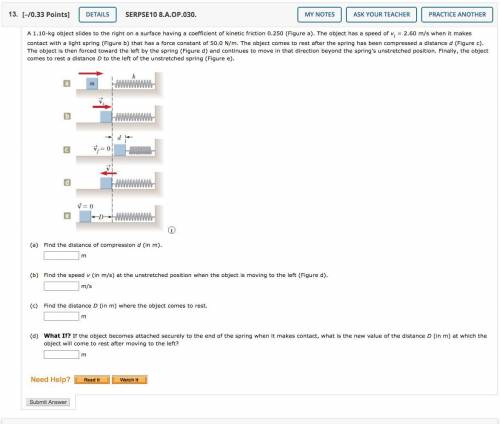
Physics, 16.10.2020 06:01 sashllely6112
A 1.10-kg object slides to the right on a surface having a coefficient of kinetic friction 0.250 (Figure a). The object has a speed of vi = 2.60 m/s when it makes contact with a light spring (Figure b) that has a force constant of 50.0 N/m. The object comes to rest after the spring has been compressed a distance d (Figure c). The object is then forced toward the left by the spring (Figure d) and continues to move in that direction beyond the spring's unstretched position. Finally, the object comes to rest a distance D to the left of the unstretched spring (Figure e).
The right end of a horizontal spring labeled k is attached to a wall. Five images show five configurations as a block labeled m approaches, compresses, and then moves away from the spring.
In figure a, the block is to the left of the spring, and an arrow above the block points to the right.
In figure b, the block is just touching the uncompressed spring, and an arrow labeled vector vi above the block points to the right.
In figure c, the block has compressed the spring by a distance d, and a label indicates vector vf = 0.
In figure d, the block is just touching the uncompressed spring, and an arrow labeled vector v above the block points to the left.
In figure e, the block is a distance D away from the spring, and a label indicates vector v = 0.
(a)
Find the distance of compression d (in m).
m
(b)
Find the speed v (in m/s) at the unstretched position when the object is moving to the left (Figure d).
m/s
(c)
Find the distance D (in m) where the object comes to rest.
m
(d)
What If? If the object becomes attached securely to the end of the spring when it makes contact, what is the new value of the distance D (in m) at which the object will come to rest after moving to the left?
m


Answers: 3


Another question on Physics


Physics, 21.06.2019 23:20
The 5-kg cylinder is initially at rest when it is placed in contact with the wall b and the rotor at a. if the rotor always maintains a constant clockwise angular velocity v = 6 rad> s, determine the initial angular acceleration of the cylinder. the coefficient of kinetic friction at the contacting surfaces b and c is mk = 0.2.
Answers: 3

Physics, 22.06.2019 01:30
The speed of light in a material is 0.50 c. what is the critical angle of a light ray at the interface between the material and a vacuum?
Answers: 1

Physics, 22.06.2019 03:30
The focal length of a relaxed human eye is approximately 1.7 cm. when we focus our eyes on a close up object, we can change the refractive power of the eye by about 16 diopters. (a) does the refractive power of our eyes increase or decrease by 16 diopters when we focus closely? explain. (b) calculate the focal length of the eye when we focus closely.
Answers: 3
You know the right answer?
A 1.10-kg object slides to the right on a surface having a coefficient of kinetic friction 0.250 (Fi...
Questions


Computers and Technology, 06.09.2019 17:10






Computers and Technology, 06.09.2019 17:10


Mathematics, 06.09.2019 17:10

Social Studies, 06.09.2019 17:10


History, 06.09.2019 17:10

History, 06.09.2019 17:10

Biology, 06.09.2019 17:10

History, 06.09.2019 17:10




 = 2.60 m/s
= 2.60 m/s
 = W × μ
= W × μ


 = 25·d²
= 25·d² = 1.10×9.81×0.250×d = 2.69775·d
= 1.10×9.81×0.250×d = 2.69775·d
 .
. .
. .
. .
. denote the mass of the block. Let
denote the mass of the block. Let  denote the constant of kinetic friction between the object and the surface. Let
denote the constant of kinetic friction between the object and the surface. Let  denote the constant of gravitational acceleration.Let
denote the constant of gravitational acceleration.Let  denote the spring constant of this spring.(a)
denote the spring constant of this spring.(a) .
. and compressed the spring by the same distance.
and compressed the spring by the same distance.  . Elastic potential energy that the spring has gained:
. Elastic potential energy that the spring has gained:  .
. .
. . In the equation above, all symbols other than
. In the equation above, all symbols other than  .
. .
. .
. .
. is
is  .
. .
. because the energy lost to friction should be greater than zero.
because the energy lost to friction should be greater than zero. .
. .
. .
. .
. .
. ) would be lost to friction.
) would be lost to friction. .
. .
. .
. .
. .
. 

